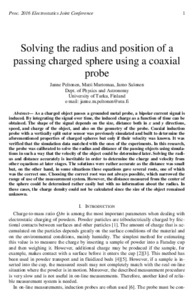Solving the radius and position of a passing charged sphere using a coaxial probe
Janne Peltonen; Matti Murtomaa; Jarno Salonen
https://urn.fi/URN:NBN:fi-fe2021042714891
Tiivistelmä
As a charged object passes a grounded metal probe, a bipolar current signal is induced. By integrating the signal over time, the induced charge as a function of time can be obtained. The shape of the signal depends on the size, distance both in x and y directions, speed, and charge of the object, and also on the geometry of the probe. Coaxial induction probe with a vertically split outer sensor was previously simulated and built to determine the aforementioned properties of charged spheres but only if their velocity was known. It was verified that the simulation data matched with the ones of the experiments. In this research, the probe was calibrated to solve the radius and distance of the passing objects using simulations in such a way that the velocity of the object could be determined later. Solving the radius and distance accurately is inevitable in order to determine the charge and velocity from other equations at later stages. The solutions were rather accurate as the distance was small but, on the other hand, in some situations these equations gave several roots, one of which was the correct one. Choosing the correct root was not always possible, which narrowed the range of use of the measurement system. However, the distance measured from the center of the sphere could be determined rather easily but with no information about the radius. In these cases, the charge density could not be calculated since the size of the object remained unknown.
Kokoelmat
- Rinnakkaistallenteet [27094]
